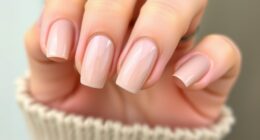Many common nail products contain chemicals like formaldehyde, toluene, and dibutyl phthalate, which can trigger allergic reactions and skin sensitivities. Hidden allergens in nail removers, adhesives, and gels may cause symptoms like redness, itching, swelling, or blistering. Repeated exposure increases the risk of long-term sensitization. To stay safe, you should choose products with transparent ingredients and consider natural options. Explore further to discover how to protect your skin from these irritants.
Key Takeaways
- Common irritants like formaldehyde, toluene, and dibutyl phthalate in nail polishes can trigger allergic reactions.
- Repeated exposure to chemicals such as methacrylates and formaldehyde-releasing agents increases skin sensitization risk.
- Hidden preservatives and fragrance additives in nail removers and products may cause allergies or sensitivities.
- Poor salon hygiene and frequent use of chemical-rich products raise the likelihood of contact dermatitis.
- Recognizing early allergy symptoms like redness, itching, and swelling helps prevent long-term skin damage.
Common Chemical Ingredients in Nail Polishes and Their Allergy Potential
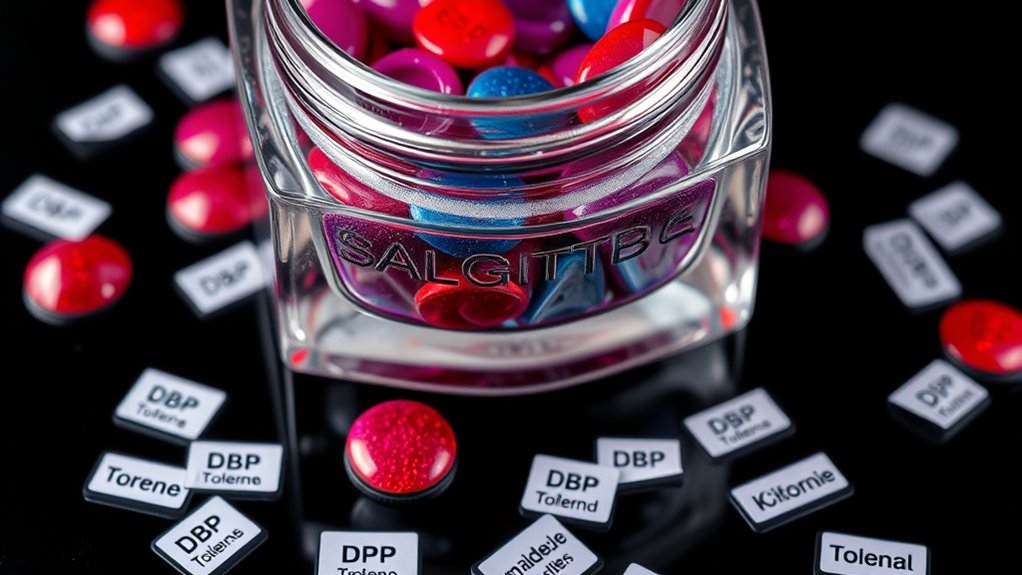
Many nail polishes contain chemical ingredients that can trigger allergic reactions in sensitive individuals. Common culprits include formaldehyde, toluene, and dibutyl phthalate, which are known irritants. To reduce your risk, look for products with natural ingredients, which tend to be gentler on sensitive skin. Label transparency is vital—reputable brands clearly list all ingredients, helping you avoid harmful chemicals. By reading labels carefully, you can identify nail polishes formulated with safer, natural ingredients and minimize allergy risks. Always opt for products that prioritize transparency and ingredient quality, especially if you have a history of sensitivities. Choosing nail polishes with natural ingredients and transparent labeling empowers you to make safer, more informed choices for your nail health. For added safety, consider cosmetic ingredient regulations that help ensure product safety and transparency.
Hidden Allergens in Nail Removers and How to Spot Them
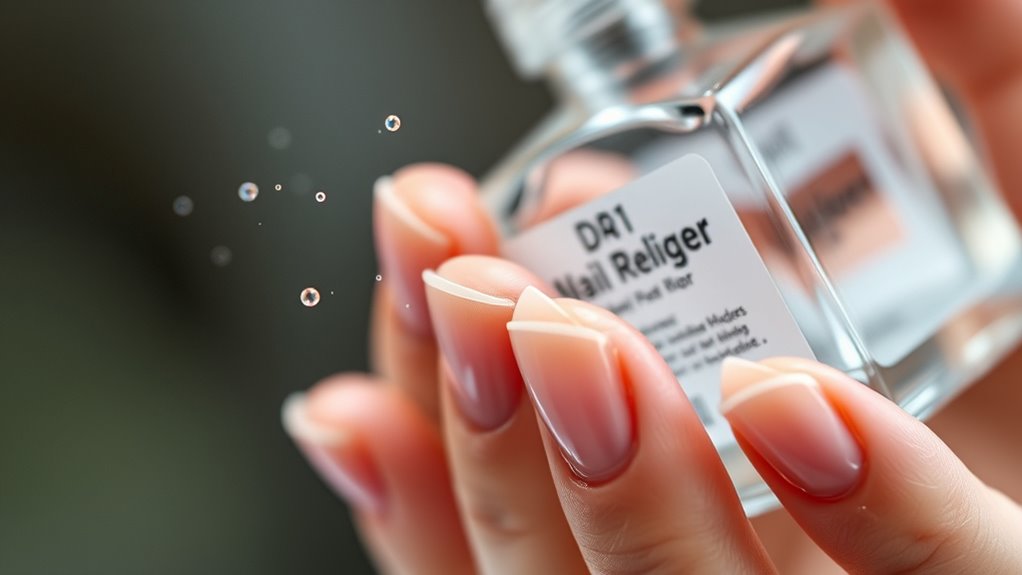
While choosing nail polishes with safe ingredients helps reduce allergy risks, it’s equally important to be aware of hidden allergens in nail removers. Many removers contain hidden preservative ingredients that can trigger allergic reactions, even if they aren’t listed prominently. These preservatives, such as formaldehyde-releasing agents, often hide behind vague labels, so reading ingredients carefully is essential. Additionally, fragrance additives are common in nail removers to improve scent, but they can cause sensitivities or allergies in some individuals. To spot these hidden allergens, look for products labeled as fragrance-free or hypoallergenic, and check ingredient lists for preservative names. Being vigilant and informed helps you avoid unexpected allergic reactions and keeps your nail care routine safer. Necessary cookies are also used to ensure basic site functionalities when researching product ingredients online. Recognizing common preservative ingredients can further help you make allergy-safe choices, especially since some allergenic substances may not be immediately obvious from the labels.
The Risks Associated With Nail Gels and Acrylics
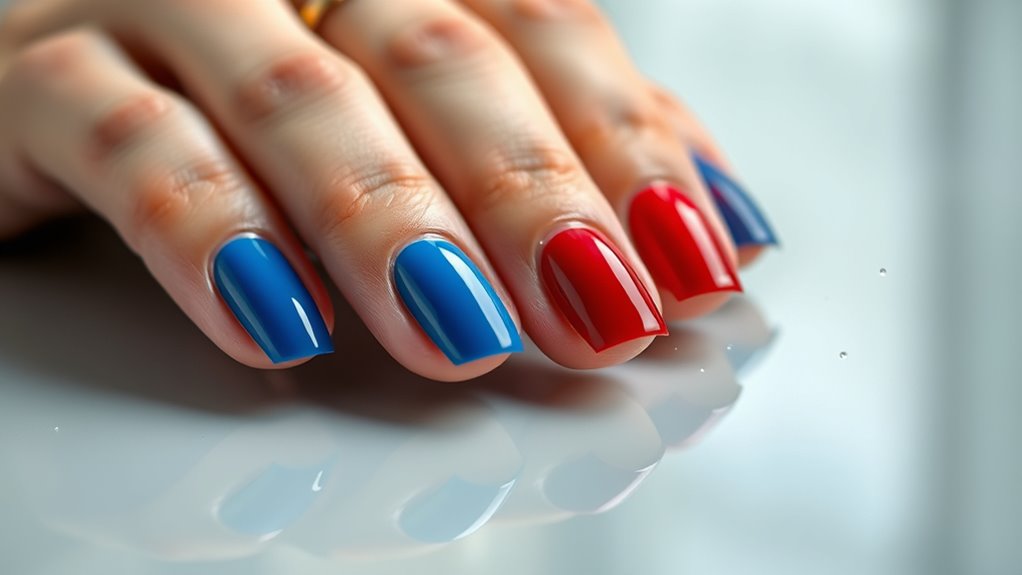
When you use nail gels and acrylics, you expose your skin to strong chemicals that can trigger allergic reactions. Repeated use increases the risk of skin irritation and long-term sensitization. Being aware of these risks helps you make safer choices for your nails. Additionally, using essential oils in skin care should be approached with caution, as some oils can cause irritation or allergic responses, especially if not properly diluted. Understanding industry trends can also inform safer application practices and alternative options. Recognizing the importance of creative practice in developing innovative solutions may inspire the industry to explore safer, more sustainable nail products and techniques. Furthermore, staying informed about vetted products ensures you select options that have been tested for safety and efficacy.
Chemical Allergens Exposure
Chemical allergens in nail gels and acrylics pose significant health risks by exposing you to potentially irritating substances. These products contain chemicals like methacrylates, formaldehyde, and toluene, which can trigger allergic reactions. Understanding nail polish history helps highlight how formulations have evolved, yet risks remain. Modern salon hygiene standards aim to reduce contamination, but chemical exposure persists through repeated use. You might not realize that even well-maintained salons use products with allergenic potential. Prolonged or frequent exposure increases the chance of developing sensitivities. Being aware of these chemical allergens can help you make informed decisions about your nail care. Always check ingredients and consider the risks, especially if you have sensitive skin or a history of allergies. Regular use of Glycolic acid in skincare routines can also improve skin resilience, potentially reducing irritation from other products. Additionally, awareness of chemical sensitivities can help you choose safer alternatives and prevent adverse reactions. Reducing chemical exposure in nail products is essential for maintaining overall health and minimizing allergy risks. Staying informed about allergen content in beauty products empowers consumers to select safer options and protect their health.
Skin Reaction Risks
Have you ever experienced redness, itching, or swelling after getting your nails done? These reactions can be signs of skin irritation from nail gels or acrylics. One common issue is cuticle damage, which weakens your skin’s barrier and increases susceptibility to infections. Damaged cuticles can also allow fungi to enter, leading to nail fungus. Additionally, frequent or improper removal of nail products can cause skin peeling and inflammation. If your skin becomes inflamed or infected, it might take longer to heal and could worsen if overlooked. To reduce these risks, guarantee proper application and removal by professionals and avoid aggressive handling of your cuticles. Recognizing early signs of skin reactions helps prevent more serious issues like fungal infections or lasting damage. Understanding skin reactions is crucial in ethical hacking, as both fields require awareness of vulnerabilities to prevent larger security breaches. Proper nail product application and removal techniques are essential to minimize skin trauma and potential infections. Moreover, choosing safe formulations free from harsh chemicals can significantly lower the risk of adverse skin reactions. Ensuring that nail products adhere to regulatory standards can also help promote safer use and reduce health risks.
Long-term Sensitization
Repeated exposure to nail gels and acrylics can lead to long-term skin sensitization, where your immune system becomes increasingly reactive to these products over time. This means that even minor contact can trigger allergic reactions, making your skin more sensitive than before. If you enjoy nail art for its polish durability, you might notice that over time, your skin reacts more strongly to gels and acrylics. Long-term sensitization can cause redness, swelling, and discomfort, impacting your ability to enjoy these enhancements. The more frequently you get these nails applied, the higher your risk of developing a persistent allergy. Recognizing early signs and limiting exposure can help prevent chronic issues and preserve your skin’s health while still enjoying your favorite nail art.
Adhesives and Glues: Potential Triggers for Allergic Reactions
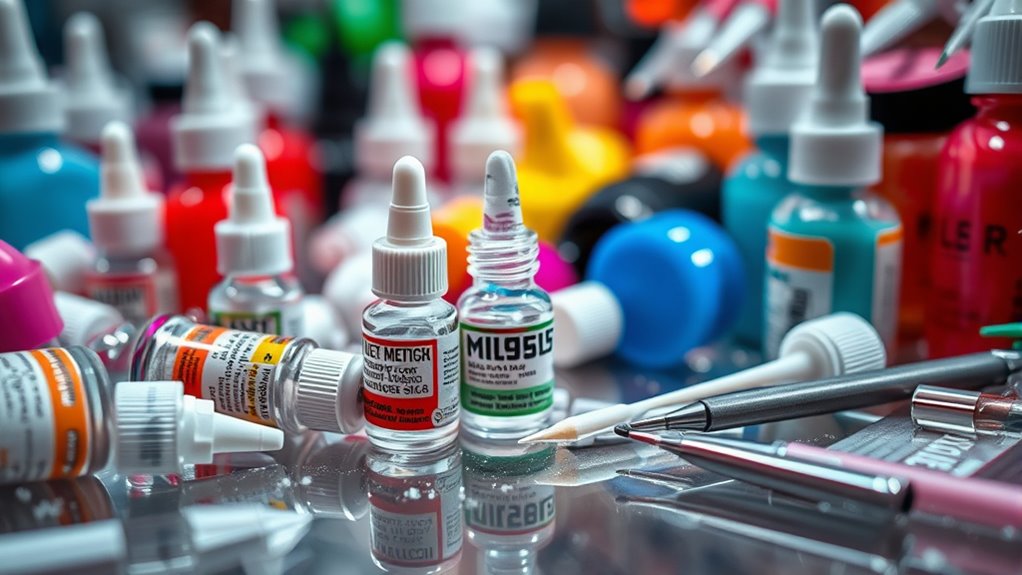
While adhesives and glues are essential for achieving flawless nail applications, they can also pose significant allergy risks. These products contain chemical compounds that interact with your skin, potentially triggering allergic reactions. One concern is chemical interactions that may cause irritation or sensitization over time. Additionally, allergen cross reactivity can occur if you’re already sensitive to certain chemicals used in other nail products or household adhesives. This means that exposure to even small amounts of these substances can lead to allergic responses. It’s important to be aware that not all adhesives are the same; some contain harsher chemicals that increase allergy risks. If you notice redness, itching, or swelling after using certain glues or adhesives, consider consulting a professional and switching to hypoallergenic options.
Recognizing Symptoms of Nail Product Allergies
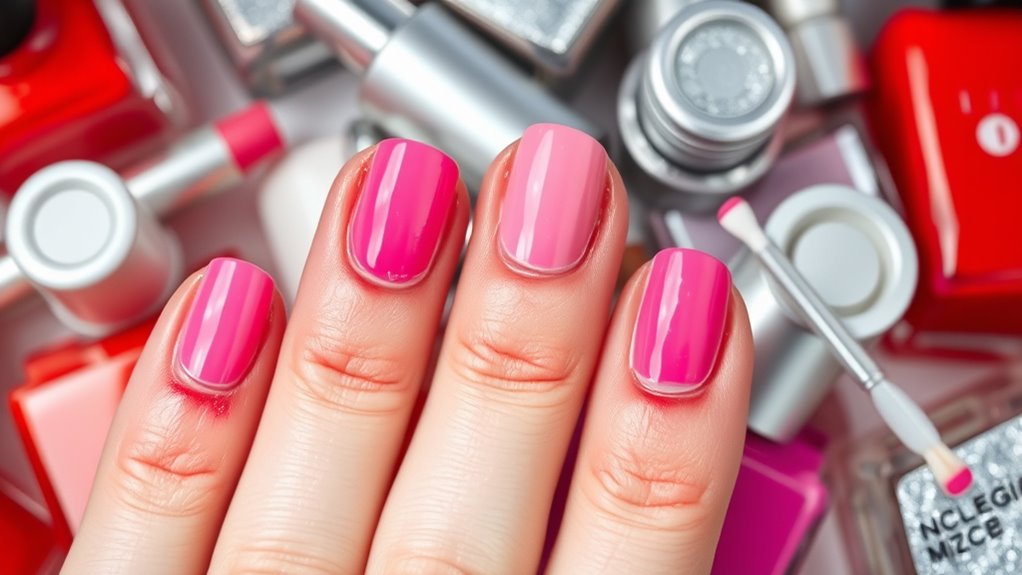
You might notice redness, itching, or swelling around your nails if you’re allergic to nail products. Skin reactions can range from mild irritation to more serious symptoms, so it’s important to recognize these early signs. If symptoms worsen or persist, you should seek medical help promptly. Being aware of allergy symptoms can help you take swift action to prevent further issues. Additionally, understanding common allergenic ingredients in nail products can aid in avoiding potential triggers. Some individuals may also experience delayed allergic reactions, which can appear hours or days after exposure, making awareness even more crucial. Recognizing the role of certifications and endorsements from beauty experts can also help identify safer, more trustworthy nail products.
Common Allergy Signs
Recognizing the signs of a nail product allergy is essential for preventing further irritation and damage. If you notice redness, itching, or swelling around your nails or cuticles, these could be allergy symptoms, especially after getting nail art or a salon visit. Bumps, blistering, or flaky skin are common indicators, and persistent dryness or staining may also occur. Poor salon hygiene can increase the risk of allergic reactions, so always choose reputable salons. If you experience any discomfort or unusual skin changes after applying nail products, stop using them immediately. Being attentive to these signs helps you identify allergies early and avoid more serious skin issues. Remember, prompt action can protect your skin and ensure a safer, more enjoyable nail care experience.
Skin Reactions Explained
When allergy signs like redness, itching, or swelling appear around your nails or cuticles, understanding the specific skin reactions can help you identify the cause. Allergic reactions often show as contact dermatitis, leading to inflamed, flaky, or blistered skin. You might notice rashes after trying new nail art designs or following popular manicure trends that involve glues, gels, or acrylics. These reactions can be localized or spread beyond the nail area, causing discomfort and irritation. Recognizing these symptoms early helps you pinpoint the allergen and avoid further exposure. Keep an eye out for persistent redness, swelling, or bumps, especially if you’ve recently experimented with bold nail art or trendy nail products. Being aware of these skin reactions ensures you can take swift action to protect your skin health.
When to Seek Help
If symptoms of an allergic reaction persist or worsen, it’s essential to seek medical help promptly. Recognizing signs early can prevent serious complications. Look for symptoms like persistent redness, swelling, blistering, or itching around your nails and skin. These reactions might appear after nail art or due to poor salon hygiene. Sometimes, symptoms may be delayed, so monitor your skin closely.
| Symptom | When to Seek Help |
|---|---|
| Persistent redness or swelling | If it lasts more than a day or worsens |
| Blistering or oozing | If blisters appear, see a healthcare professional |
| Severe itching | If it interferes with daily activities |
| Spreading rashes | When spreading beyond the nail area |
| Signs of infection | Such as warmth, pus, or fever |
Trust your instincts—prompt action ensures proper care and relief.
Safer Alternatives and Natural Options for Nail Care
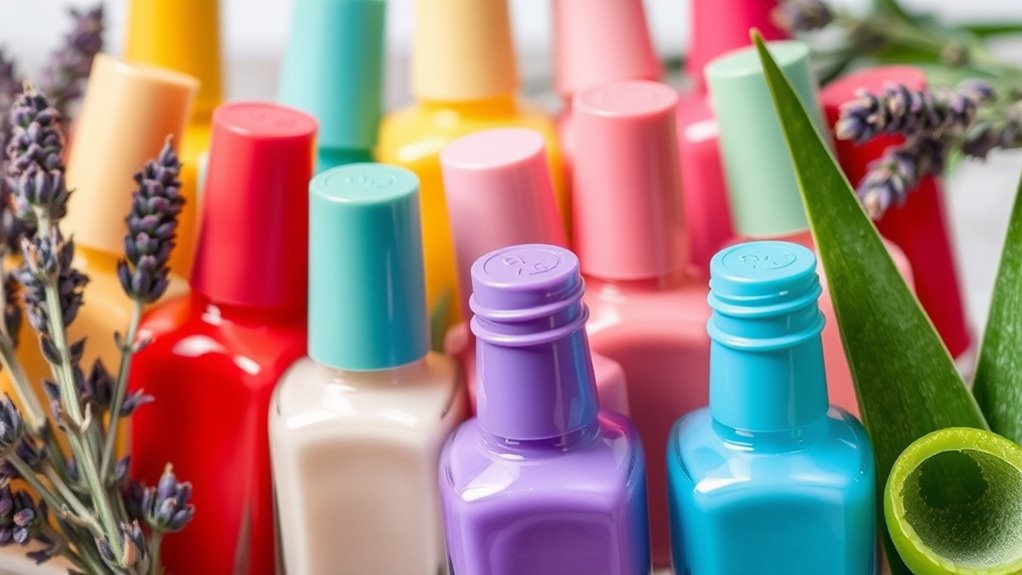
Many people are turning to safer alternatives and natural options for nail care to minimize exposure to harmful chemicals. You can explore nail art using non-toxic, plant-based polishes that avoid traditional chemicals like formaldehyde or phthalates. These eco-friendly polishes are free from harsh ingredients, reducing allergy risks while still allowing you to stay trendy with fresh polish trends. You might also consider using natural oils like coconut or jojoba for nail strengthening and cuticle care instead of chemical-laden products. DIY nail art with organic paints or water-based polishes offers a fun, safe way to express style without compromising health. Embracing these natural options not only supports healthier nails but also aligns with a more sustainable, chemical-free approach to beauty.
Tips for Patch Testing and Preventing Allergic Reactions

To reduce the risk of an allergic reaction, it’s essential to perform patch testing before trying new nail products. Patch testing helps identify sensitivities and can prevent severe reactions. To do this, apply a small amount of the product on your skin, such as behind your ear or on your inner forearm, and wait 48 hours to observe any irritation or allergic responses. If no redness, swelling, or itching occurs, it’s likely safe to use the product. Always follow manufacturer instructions for patch testing and avoid applying products directly to your nails until you’re sure you’re not allergic. Practicing patch testing is a simple yet effective step in allergy prevention, allowing you to enjoy nail care without unnecessary risks.
Choosing Salons and Products That Prioritize Safety
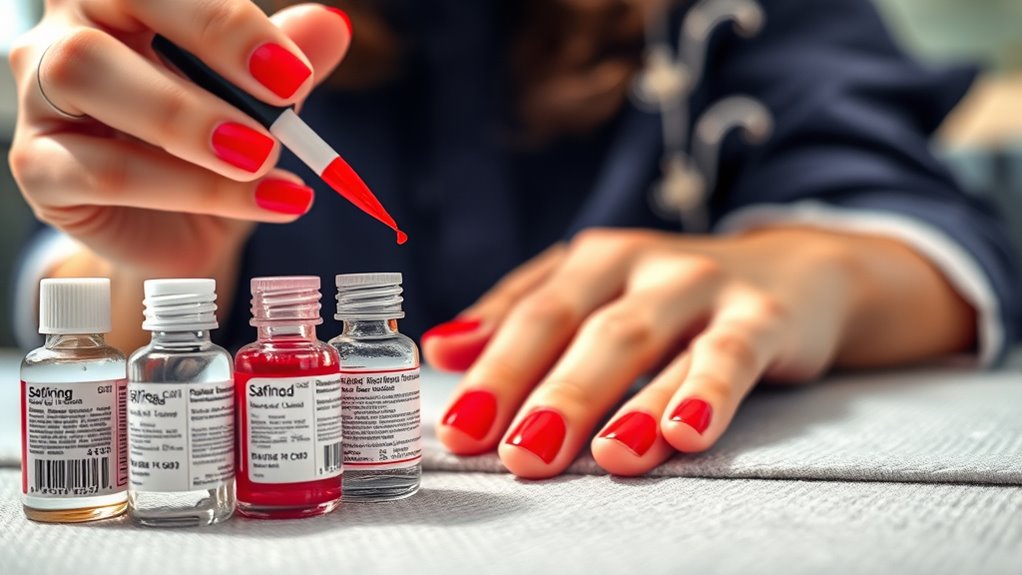
Choosing a salon that prioritizes safety is essential for reducing allergy risks associated with nail products. Look for salons that maintain high standards of salon hygiene, such as clean tools and sanitized workspaces. When it comes to nail art, guarantee the salon uses safe, non-toxic products and avoids harsh chemicals known to trigger allergies. Don’t hesitate to ask about the types of polishes, primers, and adhesives they use, especially if you have sensitive skin. A reputable salon will be transparent about their practices and prioritize client health. Consistently choosing salons that emphasize hygiene and safety reduces your exposure to potential allergens and helps prevent reactions. Ultimately, your awareness and proactive approach can considerably lower your allergy risks during nail treatments.
Frequently Asked Questions
Are There Hypoallergenic Nail Products Available for Sensitive Skin?
You might wonder if hypoallergenic nail products exist for sensitive skin. The good news is, many brands now offer hypoallergenic formulations designed specifically for people with sensitive skin. These products typically avoid common irritants like formaldehyde and toluene, reducing allergy risks. By choosing these options, you can enjoy manicures with less worry about allergic reactions, ensuring your nails look great while protecting your skin’s health.
How Long Do Allergic Reactions to Nail Products Typically Last?
Allergic reactions to nail products can last anywhere from a few days to several weeks, depending on the duration variability and individual sensitivity. You might experience redness, itching, or swelling, but effective symptom management can help shorten this period. To reduce discomfort, avoid further exposure, keep the area clean and moisturized, and consider over-the-counter antihistamines or topical treatments. If symptoms persist, consult a healthcare professional for personalized advice.
Can Nail Allergies Develop After Multiple Years of Use?
Yes, nail allergies can develop after years of use. You might experience late onset allergies or delayed reactions, even if you’ve used the products for a long time without issues. Over time, your skin can become sensitized to certain ingredients, leading to allergic responses. It’s important to monitor any new symptoms and consider testing or consulting a dermatologist, especially if symptoms appear after prolonged exposure.
What Are the Long-Term Health Effects of Nail Product Allergies?
Think of your immune system as a garden. If you’re repeatedly exposed to nail product allergens, it’s like weeds taking over, causing chronic respiratory issues or skin reactions. Long-term, these allergies can weaken your immune defenses, making you more vulnerable to other illnesses. Over time, persistent allergic reactions might lead to more serious health concerns, emphasizing the importance of recognizing and avoiding triggers to protect your overall health.
Do Natural or Organic Nail Polishes Completely Eliminate Allergy Risks?
Natural or organic nail polishes often have a different chemical composition and prioritize ingredient safety, which can reduce allergy risks. However, they don’t completely eliminate these risks because some ingredients, even if natural, might still cause sensitivities. Always check labels carefully, especially if you have known allergies, and perform a patch test to minimize potential reactions. Remember, no product can guarantee zero allergy risk entirely.
Conclusion
To protect yourself from nail product allergies, stay informed about ingredients and opt for safer, natural options whenever possible. Always patch test new products and communicate your sensitivities to salon professionals. Remember, even in an era of progress, vigilance remains your best shield against allergic reactions. By making mindful choices and prioritizing your health, you can enjoy beautiful nails without sacrificing your well-being—just as wise victors of old would prioritize their safety in battle.









